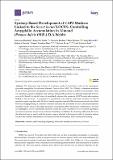Por favor, use este identificador para citar o enlazar a este item:
http://hdl.handle.net/10261/169010COMPARTIR / EXPORTAR:
 SHARE SHARE
 CORE
BASE CORE
BASE
|
|
| Visualizar otros formatos: MARC | Dublin Core | RDF | ORE | MODS | METS | DIDL | DATACITE | |

| Campo DC | Valor | Lengua/Idioma |
|---|---|---|
| dc.contributor.author | Ricciardi, Francesca | - |
| dc.contributor.author | Cueto, Jorge del | - |
| dc.contributor.author | Bardaro, Nicoletta | - |
| dc.contributor.author | Mazzeo, Rosa | - |
| dc.contributor.author | Ricciardi, Luigi | - |
| dc.contributor.author | Dicenta, Federico | - |
| dc.contributor.author | Sánchez-Pérez, Raquel | - |
| dc.contributor.author | Pavan, Stefano | - |
| dc.contributor.author | Lotti, Concetta | - |
| dc.date.accessioned | 2018-08-22T08:32:18Z | - |
| dc.date.available | 2018-08-22T08:32:18Z | - |
| dc.date.issued | 2018-07-31 | - |
| dc.identifier.citation | Genes 9(8): 385 (2018) | - |
| dc.identifier.issn | 2073-4425 | - |
| dc.identifier.uri | http://hdl.handle.net/10261/169010 | - |
| dc.description.abstract | The bitterness and toxicity of wild-type seeds of Prunoideae is due to the cyanogenic glucoside amygdalin. In cultivated almond (Prunus dulcis (Mill.) D.A. Webb), a dominant mutation at the Sk locus prevents amygdalin accumulation and thus results in edible sweet kernels. Here, we exploited sequence similarity and synteny between the genomes of almond and peach (Prunus persica (L.) Batsch) to identify cleaved amplified polymorphic sequence (CAPS) molecular markers linked to the Sk locus. A segregant F1 population was used to map these markers on the Sk genomic region, together with Sk-linked simple sequence repeat (SSR) markers previously described. Molecular fingerprinting of a cultivar collection indicated the possibility to use CAPS polymorphisms identified in this study in breeding programs arising from different parental combinations. Overall, we highlight a set of codominant markers useful for early selection of sweet kernel genotypes, an aspect of primary importance in almond breeding. In addition, by showing collinearity between the physical map of peach and the genetic map of almond with respect to the Sk genomic region, we provide valuable information for further marker development and Sk positional cloning. | - |
| dc.description.sponsorship | This work was financed by the projects “Mejora Genética del Almendro” (MINECO-Spain, AGL2017-85042-R), “The molecular mechanisms to break flower bud dormancy in fruit trees” to RS-P within the Villum Young Investigator Program and by the VILLUM Research Center for Plant Plasticity-Denmark, and “Breeding stone fruit species assisted by molecular tools” (Fundación Séneca-Spain). | - |
| dc.publisher | Multidisciplinary Digital Publishing Institute | - |
| dc.relation | info:eu-repo/grantAgreement/MINECO/Plan Estatal de Investigación Científica y Técnica y de Innovación 2013-2016/AGL2017-85042-R | - |
| dc.relation.isversionof | Publisher's version | - |
| dc.rights | openAccess | - |
| dc.subject | Almonds | - |
| dc.subject | Plant breeding | - |
| dc.subject | Mapping | - |
| dc.subject | Molecular markers | - |
| dc.subject | Kernel taste | - |
| dc.subject | Sk locus | - |
| dc.title | Synteny-Based Development of CAPS Markers Linked to the Sweet kernel LOCUS, Controlling Amygdalin Accumulation in Almond (Prunus dulcis (Mill.) D.A.Webb) | - |
| dc.type | artículo | - |
| dc.identifier.doi | 10.3390/genes9080385 | - |
| dc.description.peerreviewed | Peer reviewed | - |
| dc.relation.publisherversion | https://doi.org/10.3390/genes9080385 | - |
| dc.date.updated | 2018-08-22T08:32:18Z | - |
| dc.rights.license | http://creativecommons.org/licenses/by/4.0/ | - |
| dc.contributor.funder | Ministerio de Economía y Competitividad (España) | - |
| dc.contributor.funder | Villum Fonden | - |
| dc.contributor.funder | Fundación Séneca | - |
| dc.relation.csic | Sí | - |
| dc.identifier.funder | http://dx.doi.org/10.13039/501100003329 | es_ES |
| dc.identifier.funder | http://dx.doi.org/10.13039/100008398 | es_ES |
| dc.identifier.funder | http://dx.doi.org/10.13039/100007801 | es_ES |
| dc.identifier.pmid | 30065184 | - |
| dc.type.coar | http://purl.org/coar/resource_type/c_6501 | es_ES |
| item.fulltext | With Fulltext | - |
| item.openairecristype | http://purl.org/coar/resource_type/c_18cf | - |
| item.cerifentitytype | Publications | - |
| item.openairetype | artículo | - |
| item.grantfulltext | open | - |
| Aparece en las colecciones: | (CEBAS) Artículos | |
Ficheros en este ítem:
| Fichero | Descripción | Tamaño | Formato | |
|---|---|---|---|---|
| genes-09-00385.pdf | 1 MB | Adobe PDF |  Visualizar/Abrir |
CORE Recommender
PubMed Central
Citations
4
checked on 25-abr-2024
SCOPUSTM
Citations
8
checked on 23-abr-2024
WEB OF SCIENCETM
Citations
6
checked on 25-feb-2024
Page view(s)
265
checked on 22-abr-2024
Download(s)
227
checked on 22-abr-2024

